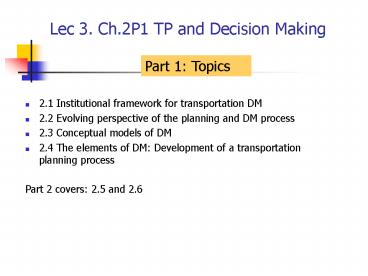Lec 3' Ch'2P1 TP and Decision Making - PowerPoint PPT Presentation
1 / 10
Title:
Lec 3' Ch'2P1 TP and Decision Making
Description:
Informal personal and group dynamic relationships that make the process work ... A wide variety of decision makings takes place in transportation planning. ... – PowerPoint PPT presentation
Number of Views:26
Avg rating:3.0/5.0
Title: Lec 3' Ch'2P1 TP and Decision Making
1
Lec 3. Ch.2P1 TP and Decision Making
Part 1 Topics
- 2.1 Institutional framework for transportation DM
- 2.2 Evolving perspective of the planning and DM
process - 2.3 Conceptual models of DM
- 2.4 The elements of DM Development of a
transportation planning process - Part 2 covers 2.5 and 2.6
2
2.1 Institutional framework for TP DM
A common characteristic of all transportation
decision making is that it occurs within an
institutional framework that is often similar
from one metropolitan area to another.
- Organizations created to provide and manage
transportation services - Formal process of interaction among, and
production from, these organizations, that is
often mandated by other levels of government - Informal personal and group dynamic relationships
that make the process work - Political, legal, and fiscal constraints
- Positive or negative roles of specific
individuals or groups
3
2.1 Institutional framework for TP DM (Example
Utah Commuter Link by UDOT)
Multiple organizations
SL Co
Informal personal group dynamic relationship
WFRC
Formal process
Div. Of Public Safety
Political, legal, fiscal constraints
SLC
See Fig 2.1 Institutional barriers.
4
2.2 An evolving perspective on the planning and
DM process
A concise history describing how the
characteristics of transportation planning
process evolved. Read and get a feel of how it
evolved, or it was forced to evolve in the past
few decades.
TP process evolved from the rational approach
to participatory approach
Public involvement
Consensus building
Amelioration project impacts
The paradigm has changed from simply
accommodating demands for increased personal
mobility to more sustainable transportation
system planning.
5
The rational approach typical steps
- Note that these steps still must exist. The
differences between the rational approach as used
in 60s and the participatory approach in later
years are, in the original rational approach - More concern on the personal mobility or lowest
travel cost, not much concern on its impacts on
the society and environment - Process itself was the goal
- Not much involvement by the public
- Comprehensive large scale
Define goals and objectives
Identify problems
Generate alternatives
Evaluate alternatives
Select optimal alternatives
(Often a lowest cost alternative)
6
2.3 Conceptual models of decision making
TDM-type planning
Region-wide rail network
Trans. planning
A wide variety of decision makings takes place in
transportation planning. And the DM process is
affected by many factors ? Make it difficult to
categorize DM types.
Type, frequency, structure, complexity of the
decisions
Characteristics, capabilities, needs of the DMs
Organizational and political context
Here the authors try to categorize DM approaches.
They apply not just transportation planning but
to any DM situations. Find a DM situation that
involves multiple agencies and people and analyze
which approach best describes its DM process.
7
5 DM approaches
8
2.4 Major characteristics of the DM process
1. Pluralistic
5. Uncertainty- avoiding
2. Resource allocative
Compromise, Negotiation, Bargaining
4. Problem- simplifying
3. Consensus- seeking Or constituency- building
Special interest groups, short-term issues
Hence, providing DMs with the knowledge necessary
to make informed decisions is the duty of the
planner.
9
Examples
- Pluralistic Referendum on transportation sales
tax (like, commuter train ¼ cent/1 tax) - Resource-allocative Adoption of a transportation
budget (lack of state budget, cancellation of a
highway project connecting Alpine and Draper) - Consensus-seeking Use of market research to
gauge the attitudes and opinions of voters facing
a referendum advisory committees to develop
plans - Problem-simplifying Defining transportation
problems as being too many cars - Uncertainty-avoiding Use of scenarios in
community visions staged implementation of
transportation projects to develop more certain
portions first
10
In summary (for ch2 part 1)
- UTP process evolved from the concept of rational
choice to the participatory or advocacy planning
approach - The characteristics of a decision-oriented
planning process depend on the type of
decision-making approach assumed. 5 processes
were presented the rational actor approach, the
satisficing approach, incremental approach,
organizational process, and political bargaining
approach. - The major characteristics of the DM process
identified in this book are pluralistic,
resource-allocative, consensus-seeking,
problem-simplifying, and uncertainty-avoiding.































